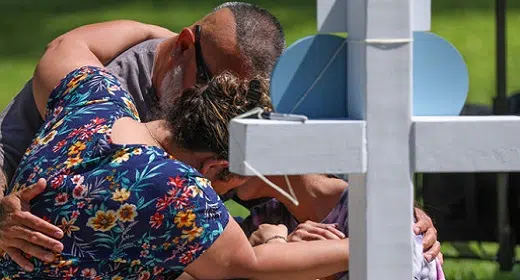by Beth Mole: Doctors and researchers say the science is clear, and it’s long past time to act…
In the wake of yet another preventable American gun violence tragedy—one that involved the slaughter of 21 people, including 19 children in a Texas elementary school—doctors, nurses, hospital administrators, health experts, and scientists are once again demanding a long-overdue, evidence-based public health response to the uniquely American public health crisis of gun violence.
This is “very much our lane,” Dr. Bindi Naik-Mathuria, a pediatric surgeon at Baylor College of Medicine in Houston, told NBC.
She spoke vividly about the immediate impacts that AR-15-style weapons have on a human body—particularly the smallest ones. In the Uvalde, Texas school shooting this week, the gunman used an AR-15-style rifle (the Daniel Defense DDM4 V7 rifle), which he bought online. AR-15-style rifles are often used in mass shootings. They use a common military-caliber ammunition. The bullets don’t always pass cleanly through flesh, but can instead become “unstable” and tumble, causing devastating damage that can leave victims unrecognizable and with an exceptionally low chance of survival.
“It’s not just the hole you see on the outside. It’s a huge blast effect,” Naik-Mathuria told NBC. “You see completely shredded organs. Vessels are completely disrupted. There’s no way to salvage them.”
The state of some of the bullet-riddled bodies of the fourth-graders killed in this week’s shooting was so grave authorities were forced to use DNA testing to identify their small corpses.
“We have our hands inside these people, these children, trying to save them,” Naik-Mathuria added. “How can anyone tell us that it’s not our problem?”
Public health’s lane
In 2018, the National Rifle Association tried to do just that, tweeting “Someone should tell self-important anti-gun doctors to stay in their lane.” But medical and health experts continued to insist that this is, in fact, their lane, starting the online movement “#ThisIsOurLane.” And their demands for action have only grown louder as gun violence has not only continued, but increased.
In 2017, firearm injuries became the leading cause of death in children and teens, overtaking motor vehicle crashes’ more than 60-year streak of being the leading cause. Between 2019 and 2020, the relative rate of firearm-related deaths of all types (suicide, homicide, unintentional, and undetermined) among children and adolescents rose 29.5 percent, according to an analysis published May 19, 2022, in The New England Journal of Medicine. Those numbers were primarily driven by an increase in the crude rate of firearm homicides in children and teens, which rose by 33 percent.

“This is about protecting people’s health. This is about protecting kids’ lives,” Michael Dowling, president and CEO of New York-based Northwell Health, told Becker’s Hospital Review this week. “Gun violence is not an issue on the outside—it’s a central public health issue for us. Every single hospital leader in the United States should be standing up and screaming about what an abomination this is.”
Overall, the US is relatively awash in guns—and gun tragedies. American civilians own an estimated 393.3 million guns, or 120.5 per 100 residents, according to a 2018 report by the Small Arms Survey. The number is likely higher today. But, that ownership rate already makes the US the top-ranking country in the world for gun ownership. Among high-income countries, Canada has the second-highest rate of gun ownership, with 34.7 guns per 100 residents, less than a third of the US rate.
Gratuitous guns
The US gun homicide rate is 26 times higher than that of other high-income countries, and its gun suicide rate is 12 times higher than that of other high-income countries.
More guns make people less safe, study after study has found. Access to firearms triples the risk of suicide and doubles the risk of homicide. States with higher rates of household firearm ownership had significantly higher homicide rates of men, women, and children, health experts at Harvard found in 2007. In 2015, another group of Harvard researchers found that states with the highest rates of gun ownership had rates of firearm assaults 6.8 times higher than states with the lowest rates of gun ownership.
In 2019, Columbia University health experts found that states with more permissive gun laws and greater gun ownership had higher rates of mass shootings. Specifically, a 10 percent increase in state gun ownership was linked to a 35 percent higher rate of mass shootings. In 2021, researchers found that more gun dealers in an area were linked to increased homicides in subsequent years.
“The common thread in all of the country’s revolting mass shootings is the absurdly easy access to guns,” Holden Thorp, editor-in-chief of the Science family of journals wrote in an editorial Thursday. “The science is clear: Restrictions work, and it’s likely that even more limitations would save thousands of lives.”
A 2017 analysis in the journal Science found that gun violence could effectively be reduced by adopting add-on sentences for gun use in violent crime, bans on gun possession by those convicted of domestic violence, and restrictions on carrying concealed firearms in public.
A 2020 study by Johns Hopkins University health researchers concluded that gun-purchaser licensing laws coupled with comprehensive background check requirements were “consistently associated with lower firearm homicide and suicide rates.” Specifically, when Connecticut adopted a handgun purchaser licensing law in 1995, the state saw an estimated 28 percent overall decrease in its firearm homicide rate and a 33 percent overall decrease in its firearm suicide rate. When Missouri repealed such a licensing law in 2007, it saw an estimated 47 percent overall increase in firearm homicides and a 23.5 percent increase in firearm suicide.
Action and prevention
Science’s Thorp called for more research into gun violence and policies, which has been severely stifled by the 1996 Dickey Amendment, lobbied for by the NRA. “Science can show that gun restrictions make societies safer. Science can show that mental illness is not a determinative factor in mass shootings,” he wrote. But, in the meantime, he urged researchers to act now. “Make protest signs. Start marching. Push lawmakers to finally break the partisan gridlock that has made moments of silence a regular observance. The National Rifle Association and its minions must be defeated.”
The American Medical Association, which declared gun violence a public health crisis in 2016, echoed the call to action. “As physicians, our mission is to heal and to maintain health. But too often the wounds we see in America today resemble the wounds I’ve seen in war,” AMA president Gerald Harmon said in a statement this week.
Harmon laid out the numerous policy recommendations the AMA has developed over the years to reduce gun violence, including waiting periods, universal background checks, gun safety education, restrictions on assault weapons, and bans on automatic repeating weapons.
“Firearm injuries and deaths are preventable,” he said, “And while the ideal time to act and find common-sense solutions and common ground might have been years ago, the best we can do now is act today. We call on lawmakers, leaders, and advocates to say enough is enough. No more Americans should die of firearm violence. No more people should lose loved ones.”
The American Academy of Pediatrics put out a similar plea this week. “There is no justification for this kind of violence anywhere,” AAP President Moira Szilagyi said in a statement.
“When will we as a nation stand up for all of these children? What, finally, will it take, for our leaders in government to do something meaningful to protect them? The AAP has called on the federal government to increase funding for research into gun violence prevention and for common-sense laws that protect everyone in a community… We owe it to the children in that classroom in Uvalde and the many others who will go into their classrooms tomorrow to speak up for them, to not rest until we see real, meaningful policy change. Until their lives are protected.”


















































